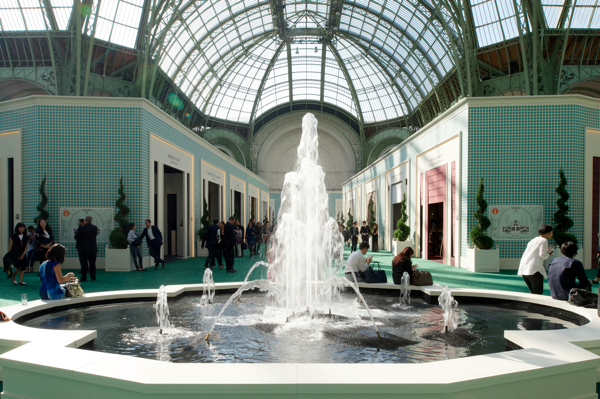
The 27th edition of Paris’s Biennale des Antiquaires et de la Haute Joaillerie didn’t exactly start under the best of circumstances. A couple of months before its public opening on September 11, Christian Deydier, the president of the Syndicat National des Antiquaires (SNA)—France’s national antique dealers federation, which organizes the event—was abruptly dismissed by the organization’s board (“President of France’s National Antique Dealers Federation Ousted”). The court rejected his subsequent appeal, and Jean-Gabriel Peyre is now interim president until elections are held next month.
But the show must go on and exhibitors didn’t let these internal struggles dampen their spirits. When it opened to VIPs and press yesterday, the Biennale was a model of refined elegance, all natural light, champagne, and airy aisles. Interior designer Jacques Grange tapped the core of the French heritage: he reimagined the Grand Palais as a pleasure garden, loosely inspired by Versailles. “We’ve been told that we were too classic,” SNA president Peyre told artnet News, “I say, no, we are people who love our past.”
Organized like the flowerbeds in a jardin à la française, the booths of the 89 exhibitors are covered with a trellis-like motif. These, combined with the skylight and delicate perfume coming from a fragrant fountain courtesy of Francis Kurkdjian, make for an almost-bucolic experience.
The Biennale des Antiquaires is a veteran of the fair world. Organized by the SNA since 1962, it fiercely defends its unique character and appeal, fueled by the perceived romanticism of the French capital and the exceptional location of the Grand Palais. Peyre brushed off any comparison with competitors like Maastricht’s TEFAF or London’s Masterpiece: “People come here looking for quality, like at the others fairs, but also for this little extra that the French have.”
In Paris, the Biennale is an unmissable event in the social calendar. Over 1,500 guests came to the gala dinner, including actress Juliette Binoche; the Prince of Venice and Piedmont, Emanuele Filiberto di Savoia; model Natalia Vodianova; and luxury magnate Antoine Arnault (“French Stars Shine at Biennale des Antiquaires Gala“). Although business is rumored to be brisk, money talk is frowned upon here. Dealers are tight-lipped but smiling. Several confided to artnet News that they were “very happy.”
“Bijou” is the first word that comes to mind when attempting to describe the atmosphere of the Grand Palais; “scholarly” and “focused” shortly follow. Dominique Lévy has collaborated with Peter Marino Architect and tribal art dealer Bernard de Grunne for a spectacular booth teasing out formal links between modern and African art. The star of her display, which also features works by Hans Arp, Yves Klein, and Nicolas de Staël, is a large oil on canvas by Joan Miró, Femme et oiseaux dans la nuit (Woman and Birds in the Night) (1968).
“The Biennale remains an extraordinary place to show extraordinary things,” said decorative art dealer Michel Giraud, who sees the event as a “real statement about the place of French dealers in the global market.” He’s come with an exquisite, tiny clay sculpture of a faun by Pablo Picasso, one of only eight known worldwide. The piece has an impeccable—and romantic—provenance: Picasso gave it to the French mountaineer Maurice Herzog, who stopped at Vallauris on his way back from the Himalayas. It had remained in the same collection ever since.
At Richard Green, a large painting by Marie-François Firmin-Girard, Le Quai aux Fleurs (1875), shows Paris’s flower market in such vivid hues that it seems like a snapshot of the late 19th century. It is particularly moving presented here at the Grand Palais, located less than a couple of miles away from the scene it depicts. The piece was a great success when it was first shown at the Salon in 1876, and it immediately entered an American collection. It is now back in Paris for the first time in more than a century.
Claude and François-Xavier Lalanne, best known for their sculptures at the crossroad of fine and decorative art, are well represented here—and it’s no surprise. Their prices shot up in the wake of the Yves Saint Laurent and Pierre Berger sale at Christie’s Paris in 2009 and their popularity took a global turn with the inclusion of Claude Lalanne’s furniture in Peter Marino’s design for the Chanel boutiques. The artists’ historical dealer, Galerie Mitterrand, has created a garden-within-a-garden, showcasing François-Xavier Lalanne’s utilitarian bestiaries: a bird-chair, a crocodile-bench, and grasshopper-bar, with prices topping at $1.5 million. The artist is also featured prominently at the booths of the Galerie Jean-David Botella and Galerie Xavier Eeckhout.
It all seems like very smoothly run operation. But under the surface, some are concerned by the impact of Deydier’s dismissal.
“I’m very fond of Deydier and have a lot of respect for him,” said Dominique Lévy, who called the former president “an extraordinary ambassador” for the Paris event. “I thought it was very sad that he was dismissed weeks before the Biennale, and you can feel it. It’s a little bit chaotic—things are not really well organized.” While Lévy is a stalwart of the Paris event, she’s now hoping that the SNA will elect a president able to carry forward the Biennale’s international ambitions.“It’s not guaranteed you’ll find me here again in two years,” she told artnet News. “It will depend who is the leader. The organization needs a leader.”